版权所有:内蒙古大学图书馆 技术提供:维普资讯• 智图
内蒙古自治区呼和浩特市赛罕区大学西街235号 邮编: 010021

作者机构:Telecommunication Program Faculty of Science and Technology Nakhon Pathom Rajabhat UniversityNakhon Pathom 73000 Thailand Department of Electrical and Computer EngineeringNational University of Singapore Singapore Computer Industrial Technology Program Faculty of Science and Technology Nakhon Pathom Rajabhat UniversityNakhon Pathom73000 Thailand
出 版 物:《Procedia Engineering》 (工程学会议集)
年 卷 期:2012年第32卷
页 面:329-335页
学科分类:12[管理学] 1201[管理学-管理科学与工程(可授管理学、工学学位)] 08[工学]
主 题:Underwater acoustic network MAC protocol design Channel listening Collision avoidance
摘 要:A MAC protocol that depends on overheard information for its collision avoidance, such as Carrier Sense Multiple Access (CSMA) [1], may not work well in underwater, due to the long propagation delay characteristic of an underwater acoustic (UWA) channel. In such channel, the overheard information may already become obsolete by the time it reaches the node and, thus, should not be taken into account in the collision avoidance mechanism. Intuitively, the degree of usefulness of overheard information plays an important role in determining the network performance for channel listening-based MAC protocols. In this paper, we analytically study the usefulness of overheard information for collision avoidance in two different channel listening-based MAC protocols: (1) CSMA [1] and (2) Aloha-CA [2]. From our study, it is shown that the overheard information is beneficial for collision avoidance only if certain conditions can be satisfied. More specifically, in order for a node that overhears an ongoing transmission to be able to utilize the extracted information for collision avoidance, the node must be within a bounded region that is determined by the relative positions of the sender and the receiver, the packet s transmission time, as well as the length of the packet s header. Based on this analysis, we also present the “usefulness index (U) which is defined as the degree of usefulness of information overheard.